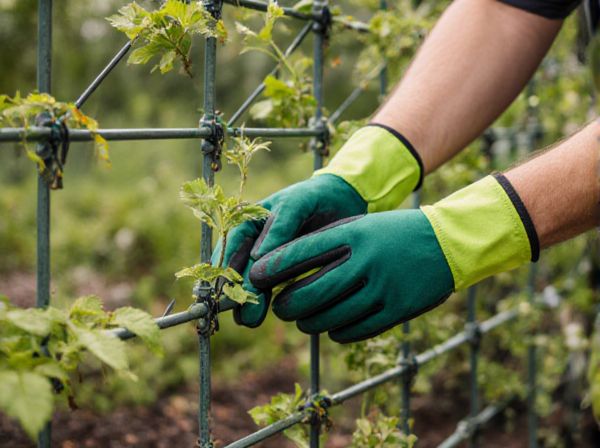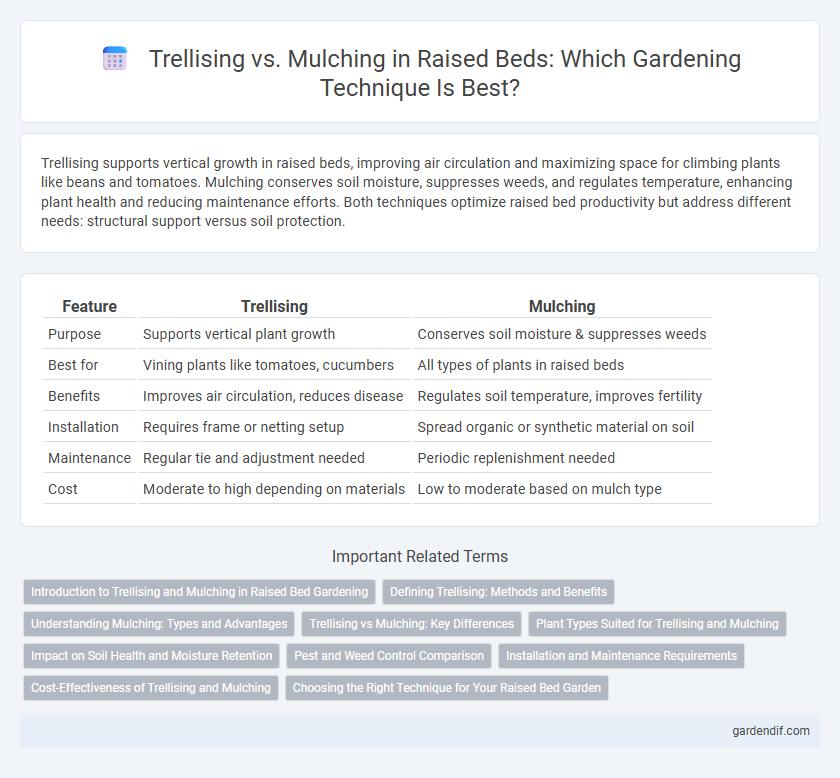
Trellising vs Mulching Illustration
Trellising supports vertical growth in raised beds, improving air circulation and maximizing space for climbing plants like beans and tomatoes. Mulching conserves soil moisture, suppresses weeds, and regulates temperature, enhancing plant health and reducing maintenance efforts. Both techniques optimize raised bed productivity but address different needs: structural support versus soil protection.
Table of Comparison
| Feature | Trellising | Mulching |
|---|---|---|
| Purpose | Supports vertical plant growth | Conserves soil moisture & suppresses weeds |
| Best for | Vining plants like tomatoes, cucumbers | All types of plants in raised beds |
| Benefits | Improves air circulation, reduces disease | Regulates soil temperature, improves fertility |
| Installation | Requires frame or netting setup | Spread organic or synthetic material on soil |
| Maintenance | Regular tie and adjustment needed | Periodic replenishment needed |
| Cost | Moderate to high depending on materials | Low to moderate based on mulch type |
Introduction to Trellising and Mulching in Raised Bed Gardening
Trellising in raised bed gardening maximizes vertical space by supporting climbing plants like tomatoes and cucumbers, improving air circulation and access to sunlight. Mulching involves covering the soil with organic materials such as straw or wood chips, which conserves moisture, suppresses weeds, and regulates soil temperature. Combining trellising and mulching enhances plant health and yield by optimizing growing conditions within limited space.
Defining Trellising: Methods and Benefits
Trellising in raised beds involves supporting plants vertically using structures such as stakes, cages, or grids, which maximizes space and improves air circulation. Methods include using bamboo poles, wire mesh, or wooden frames to guide vine growth and reduce soil contact, minimizing disease risks. Benefits encompass enhanced sunlight exposure, easier harvesting, and increased yield for climbing crops like tomatoes, beans, and cucumbers.
Understanding Mulching: Types and Advantages
Mulching in raised beds involves covering the soil surface with organic materials like straw, wood chips, or compost to retain moisture, suppress weeds, and regulate soil temperature. Organic mulches gradually decompose, enriching the soil with nutrients and improving microbial activity, while inorganic mulches such as plastic or landscape fabric provide long-lasting weed control and moisture retention. Selecting the appropriate mulch type enhances plant health, boosts crop yield, and reduces water usage in raised bed gardening systems.
Trellising vs Mulching: Key Differences
Trellising supports vertical plant growth, improving air circulation and maximizing space in raised beds, while mulching involves covering the soil to retain moisture, regulate temperature, and suppress weeds. Trellising is essential for climbing plants like tomatoes and cucumbers, promoting healthier yields, whereas mulching benefits root crops and leafy greens by maintaining soil health. Both methods enhance productivity but target different aspects of plant development and bed maintenance.
Plant Types Suited for Trellising and Mulching
Vining plants like tomatoes, cucumbers, and beans benefit from trellising as it supports vertical growth and maximizes space in raised beds. In contrast, low-growing crops such as strawberries, lettuce, and root vegetables thrive with mulching, which conserves moisture and suppresses weeds. Combining trellising with mulching can optimize conditions for mixed plant types by improving air circulation and soil health.
Impact on Soil Health and Moisture Retention
Trellising in raised beds enhances air circulation and root development, reducing soil compaction and promoting healthy microbial activity. Mulching significantly improves moisture retention by minimizing evaporation and stabilizing soil temperature, which supports beneficial soil organisms. Combining both methods optimizes soil health, ensuring balanced moisture levels and robust plant growth.
Pest and Weed Control Comparison
Trellising in raised beds enhances pest control by improving air circulation and reducing contact between plants and soil-borne pests, while mulching suppresses weeds by blocking sunlight and retains soil moisture to deter pests like slugs and aphids. Mulch materials such as straw, wood chips, and landscape fabric provide a physical barrier that inhibits weed germination, whereas trellises support vertical growth, minimizing weed competition around the plant base. Combining trellising with organic mulching maximizes pest and weed control efficiency in raised bed gardening.
Installation and Maintenance Requirements
Trellising in raised beds requires installing sturdy supports such as stakes, cages, or netting to guide plant growth vertically, which demands periodic adjustments and inspections to ensure stability and plant health. Mulching involves spreading organic or inorganic materials over the soil surface, significantly reducing watering frequency and weed growth with minimal ongoing maintenance besides seasonal replenishment. Trellising generally requires more hands-on involvement for setup and plant management, while mulching offers a simpler, lower-maintenance method to protect soil and conserve moisture.
Cost-Effectiveness of Trellising and Mulching
Trellising in raised beds offers a cost-effective way to maximize vertical space and improve air circulation, which can reduce plant diseases and boost yield per square foot. Mulching, while also affordable, primarily conserves soil moisture and suppresses weeds, cutting down on water and labor expenses over time. Comparing costs, trellising materials like bamboo or wire may require a higher initial investment, but mulching with organic materials often needs regular replenishment, affecting long-term savings.
Choosing the Right Technique for Your Raised Bed Garden
Trellising in raised bed gardens maximizes vertical space by supporting climbing plants like tomatoes and beans, improving air circulation and reducing disease risk. Mulching conserves soil moisture, suppresses weeds, and regulates soil temperature, enhancing plant growth and soil health. Selecting between trellising and mulching depends on crop type, available space, and specific garden conditions to optimize yield and maintenance.
Trellising vs Mulching Infographic

 gardendif.com
gardendif.com